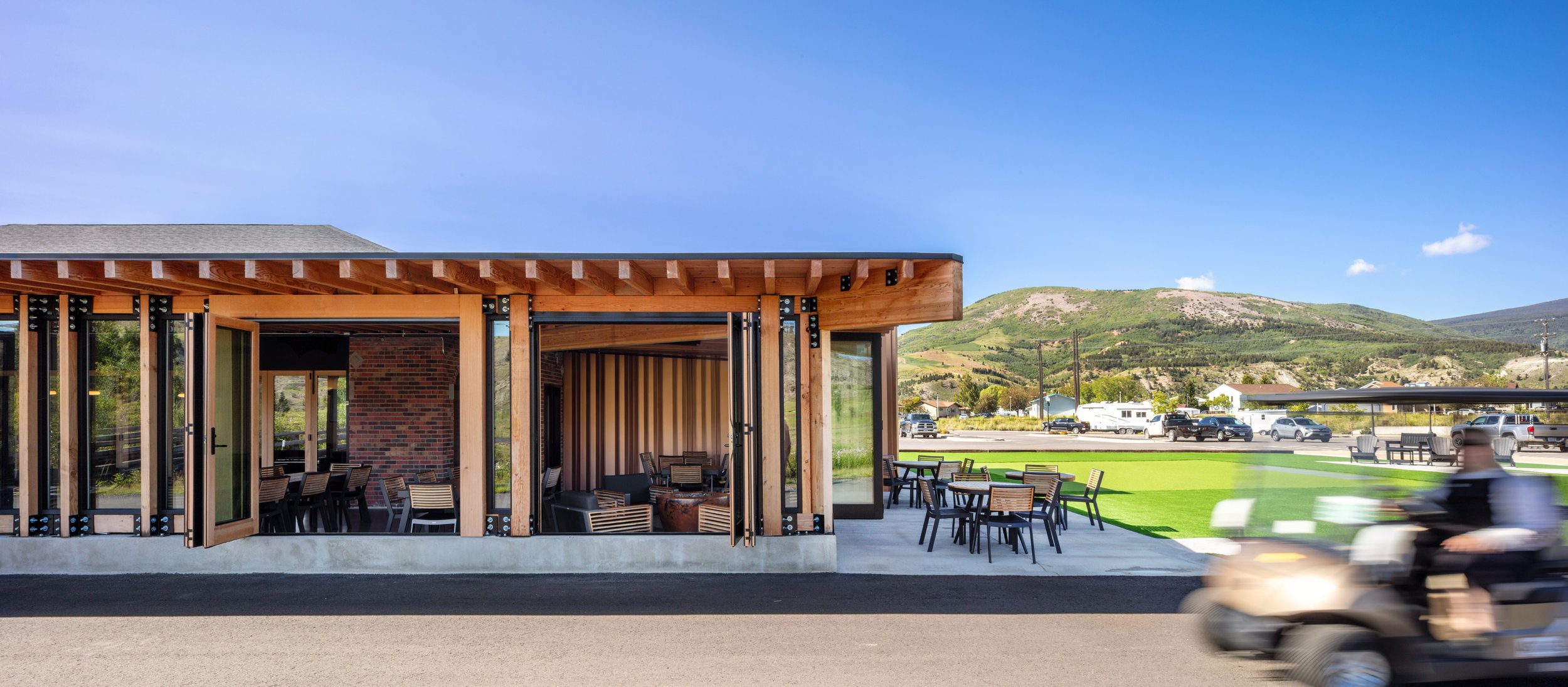JA in ArchDaily: Bringing Comfort and Warmth to Public Spaces
/This article by Eduardo Souza first appeared in ArchDaily on January 18, 2024
the teen area in the winthrop library features comfy bean bag chairs and window seats / photo by lara swimmer
Public spaces, whether indoors or outdoors, public or private, are characterized as places for encounters, opportunities, and exchanges of ideas or goods, and ultimately, they are a key part of a city's identity. However, with the rise of the internet and social networks, many of these functions have migrated to the virtual environment or lost some of their relevance. In addition, we experienced a setback in in-person relationships during the long period of isolation that accompanied the pandemic. Faced with these challenges, architects are confronted with the fundamental question of how to revitalize these crucial spaces for society, while understanding their vital importance. Can design be the key to reviving public spaces? How can we make places that are both everyone's and no one's truly comfortable?
The architecture firm Johnston Architects (JA), based in Seattle, USA, has been striving to implement this change in collective spaces by incorporating comfortable traditional elements from single-family homes and hospitality spaces into the realm of public projects and mixed-use spaces. This transformation is a response to the evolving ways in which we connect and collaborate. The goal is clear: to make public spaces more inviting, community-oriented, and, why not, more like "homes." We spoke with Lina Baker, an NCIDQ-certified Associate at JA and interior designer, who shared her insights on how her office breathes life into these transformations and important considerations for designers.
this lobby in a mixed-use residential building in seattle’s central district feels like a well-curated personal library / photo by lara swimmer
“As designers, we can easily forget that our homes come together organically, gradually over time. We acquire a sideboard here, a piece of art there, a lamp here, an area rug there—this piecemeal method results in spaces that feel lived-in and unique. We each also create our homes within the context of our own identities, which is a luxury that public-facing design does not allow us. When we design public spaces, we should be continually asking ourselves how to create some of the bespoke feeling of a curated home, rather than using the more typical “matching” scheme that offices and libraries of the past have used.”
Promoting Comfort Through a Cohesive and Eclectic Design
Design for a common-use space doesn't always have to be minimal. In terms of the challenge of layering materials, textures, and colors to promote comfort in public spaces, Baker challenges the notion of commercial design as minimal and devoid of identity. She advocates starting with a strong design narrative and developing a general palette to guide a cohesive design, encouraging designers to envision themselves in the space, and visualizing ways to introduce eclectic and unexpected elements for successful implementation. Emphasizing the importance of variety, she suggests choosing finishes or items with a common thread of similarity, but without direct matching, to support a lasting and curated aesthetic experience.
this semi-private reading and study space is an example of warm, residential design in public spaces, in this case a multifamily building lobby / photo by rafael soldi
“Paying attention to the words we use to describe spaces is also a great indicator of the approach we should start with. Words like "comfortable" and "cozy" are strongly evocative of a particular feeling, and carry with them indicators for how to drive design. For example, furniture that appears softer and more rounded as opposed to strong angles and firm seats.” - Lina Baker
Balancing Functionality, Warmth and Durability
In the realm of public space design, the delicate balance between functionality, warmth, and durability is crucial. Lina Baker clarifies this challenge, stating: "Generally, the function drives how the space is positioned (e.g., community-oriented spaces like fitness centers vs. solitary-use spaces like co-working pods), and the fittings of the space play a critical role in the invitation to use those spaces." She emphasizes the fundamental role of lighting in this context, stating that it is one of the most important factors in shaping the overall atmosphere and guiding the use of space. The intensity and design of lighting should be tailored to each intended use of the space. "Lighting is only successful when paired with carefully curated finishes and furnishings that draw users into the space; [they] should reflect the function while maintaining the aesthetic identity of the overall project."
Baker highlights the differentiated approach required, acknowledging that different spaces, such as community-oriented fitness centers or solitary-use co-working spaces, demand very distinct design considerations. She also emphasizes the need for the use of commercial-grade finishes and furniture, ensuring longevity and durability in high-traffic public areas.
Understanding the User for an Inclusive and Comprehensive Design
Designing successful public spaces also requires an understanding of the public to ensure inclusivity. This is particularly complex for public spaces, as you are designing a space that will be used by diverse individuals with multiple physical characteristics, educations, and backgrounds, who ultimately should feel comfortable and blend into the environment.
“For example, in a hypothetical scenario, your target demographic of mostly emerging professionals in their mid- to late-20s is likelier to be largely able-bodied and more interested in social connection. Groupings of soft seating at lower heights, and larger community tables support the casual social function of this demographic. However, to cater to the outlier cases, providing taller lounge seating with arms allows mobility-impaired users to have a similar experience within the same spatial context. Smaller 2- and 4- person tables provide a range of experiences for the less-socially inclined, and infuse an element of flexibility into the space.”
The issue boils down to how to create equity in an environment, addressing the different spatial needs of all individuals, and then framing all these choices in a demographically appropriate visual concept. We use disparate values as the main factors because they often require more careful consideration—wider hallways for wheelchair access, tactile floors for the visually impaired, or even something as simple as wider chairs to accommodate larger bodies. Interior spaces are transformative when users can interact seamlessly with them, without having to take into account their specific circumstances, and this is true regardless of the project's target audience.
community amenity rooms in multifamily housing projects like kirin are being used to inspire warmer and more inviting seating and study spaces in libraries / photo by rafael soldi
Harmonizing Enduring Design with Evolving Trends
The challenge of balancing enduring design elements with evolving trends leads Baker to share her perspective on design longevity. She advocates for a more liberal stance, stating: "Great design endures, even when leaning heavily into a trend or specific theme." Baker believes that the strength of the concept and the designer's ability to execute it are crucial for achieving enduring design.
Recognizing the cyclical nature of design elements, Baker notes that many elements used in interior spaces today have historical roots. She encourages designers to trust their concepts, explore sophisticated versions of design options, and incorporate modern motifs into a well-thought-out overall design to create lasting personality and distinction in a space.
“It’s also interesting to note that many of the design elements we use in interior spaces today have shown up over and over and over throughout the long history of international interiors. While the application and overall aesthetic picture vary, there are design elements which have truly stood a significant test of time. The curved archway currently en vogue is a wonderful example of a key element seen throughout historical interiors dating back as early as the 2nd millennium BC that –when applied well, within a modern context– has had legitimate staying power. I think using trendy motifs within a sophisticated, thoughtful overall design can be a great way to create lasting personality and distinction in a space.”
this gathering space at the oak tree senior living community in lacey, washington features soft, stationary seating with arms to assist residents with mobility challenges / photo by rafael soldi
Flexibility and Adaptability
These two characteristics should take center stage in the art of orchestrating design for collective-use spaces. In doing so, the use of modular and movable furniture, as well as the control of micro-level lighting facilitated by floor or table lamps, not only allows users to customize their experience but also encourages the intended use of the space. Furthermore, the wide range of finishes and furniture options can cater to various functional requirements, with a deliberate infusion of variety to resonate with the diverse comfort preferences of a broad audience. Whether it's individual preference or the sensory experience of design, prioritizing options ensures overall user satisfaction.
Still, she emphasizes that as designers, no matter how much we strive, we can only suggest that such spaces be used in a specific way, but acknowledges that this design is rarely absolutely prescriptive.
“For some, comfort means firm seats, for others, soft; some people prefer bright lights, others prefer dimness. The sensory experience drives comfort, so providing options supports overall user enjoyment.” - Lina Baker
By adopting an approach that prioritizes comfort and user experience, we redefine not only the concept of design but also the way we interact and connect in the spaces that shape the cities and communities of the future. In a dynamic world, design emerges as a powerful tool to transform public spaces into inviting, inclusive, and enduring places.
the ja-design oldworks clubhouse in anaconda, montana is an example of blurring the lines between hospitality and public spaces / photo by cody brown






